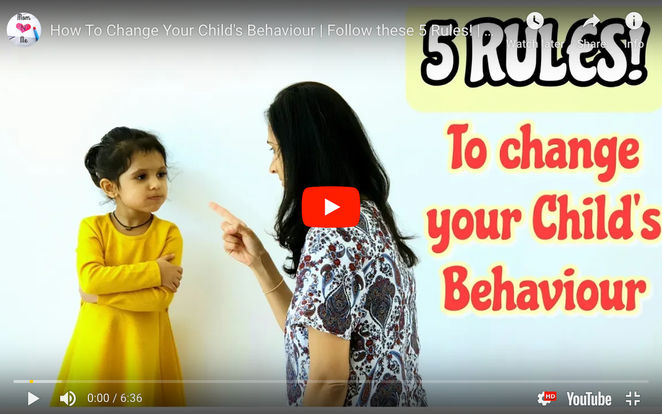How to discipline your child

Whenever we think about discipline, the first few words that come to our mind are spanking, yelling, consequences and timeouts. However, today I will discuss how you can successfully discipline your child by being honest, calm, firm and most importantly "being consistent". This method is part of positive and respectful parenting.
This 5 step discipline method is inspired by a book called "No bad kids" by Janet Lansbury who has helped many parents deal with difficult parenting issues through a positive parenting approach.
Discipline works best when it’s firm but fair. So, let's look at what these 5 steps are...
5 Steps to discipline using a gentle but firm approach:
1. Set a limit clearly - If your toddler is testing and pushing your limits, it is a clear signal that your child needs some rules and boundaries. So setting clear limits is the number 1 step in disciplining. Kids need absolutely clear boundaries to feel safe and there need to be consequences if they push the boundaries and do not follow the rules.
For instance, if your child drops food or plays with it, simply put the food away. If your child is upset..simply say... "I understand you are upset, we will be eating again soon".
Another example is if your child throws toys or puts them in the mouth - move the toys away setting clear limits that toys are not to be thrown or put in the mouth.
2. Acknowledge desires or feelings - If your child is upset due to a set boundary, acknowledge their feelings.
For instance, if your toddler hits and you stop him by holding his hand and telling him..I won't let you hit. And if this upsets your toddler..acknowledge his feelings. "I know you are upset but I cannot let you hit your big sister. It hurts!"
3. Follow through - Be prepared to take action if your child does not listen to you.
Do not give too many chances. If you give too many chances, you push yourself further than you can handle, which results in yelling and screaming, so follow through immediately.
Follow immediately is what Janet suggests in the book. However, I use a 3 strike rule. The first time I set a clear boundary....second time is warning and 3rd time is taking action.
Eg. If your toddler puts something in mouth and you don't want him to. Set a rule "I don't want you to put a stick in your mouth". If he still does, warm him "I will have to take this away if you still put it in the mouth". If it happens 3rd time...Calmly take it away.
If your toddler cries, acknowledge that "I know you want to put this stick in your mouth but it's not safe". Let the tantrum pass.
If you do not follow through what you say at this age than think about when they will grow up and turn into teenagers. They will not listen and never take you seriously.
There has to be a consequence and the consequence has to be fair. Do not use punishments as consequences since punishments are trivial. Instead, maintain your calm and take away a privilege like saying and acting on "no screen time today", or if they drop food.."lunchtime is over!".
So, following through is a very important step in disciplining children. Even if that means that you have to leave all groceries at the pay counter, pick your crying toddler and leave, just to teach them a lesson.
● Few other examples of following through:
- Holding your child’s hands as she tries to hit
- Removing an unsafe object from her hands
- Putting toys or objects away
- Moving your child out of a situation in which she’s stuck testing
● Discipline mistakes - yelling, not setting limits early enough, not following through.
4. Accept your child’s negative response - If your child cries and throws a tantrum because of your follow-through, just be patient and calm and let the crying pass, just like a storm.
5. Reconnect - Once your child stops crying, acknowledge your child's feelings again.
For example, my 3-year-old daughter gives me a hard time every day in the afternoon naptime. She does not want to sleep, neither wants to play independently while I put my 20 months old for an afternoon nap. Also if she herself does not sleep, evenings are full of meltdown cries. So, I have set a clear limit that no matter what you have to take a nap in the afternoon.
She cried for a few days, was put to another room till her tantrum was let to pass, as I didn't want my 20 months old to wake up and start crying too. After a few rough sessions, she now understands her expectations and follows my directions.
Handling these situations with empathy and acceptance will pre-empt the cycle and prevent them from becoming a daily occurrence. Do not hold the grudge or think your child is bad or misbehaving. Forget about the incident and reconnect with your child.
Lastly, If your toddler screams and yells, we cannot prevent such occurrences. Our children are in control of these actions. However, by underreacting we can deactivate these “buttons” so that children quickly lose interest in pushing them. So do not over-react. Hope this helps. Happy Parenting!
Do you have any other tips to share in disciplining a child? If so, please comment below!
Be the first to support
Be the first to share
Comment (0)
Related Blogs & Vlogs
No related events found.
Loading more...
